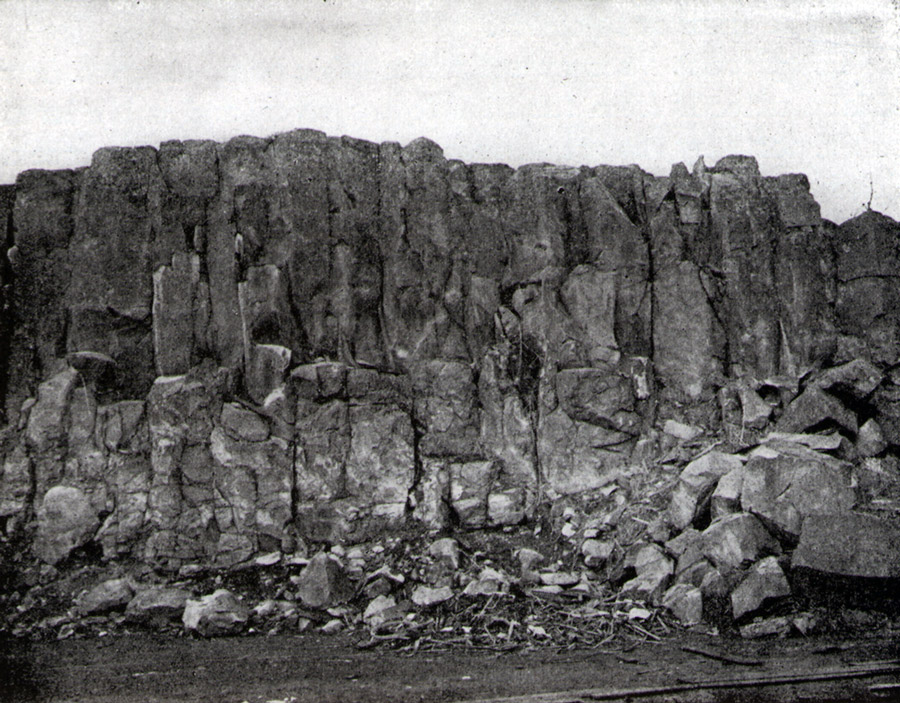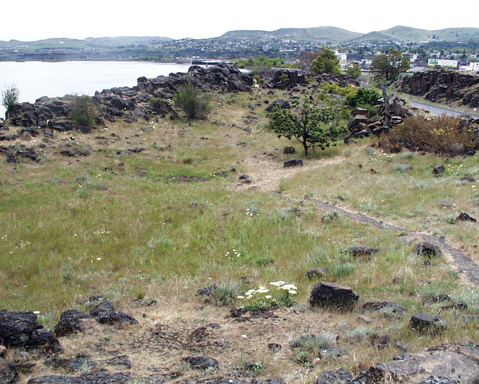“We took possession of a high Point of rocks to defend
our Selves in Case the threts of those Indians below
Should be put in execution against us.”
Fort Rock
The Dalles, Oregon
Photographer unknown, from Olin D. Wheeler, The Trail of Lewis and Clark. See also Wheeler’s “Trail of Lewis and Clark”.
This steep-walled stack of volcanic rock—columnar basalt—presented the expedition with a timely opportunity to rest for a few days in a secure location, safe from surprise assaults. Note the scrubbed appearance of the lower half of the cliff, indicating the once-normal depth of the river here at the height of the annual spring runoff in June. This photograph was taken in 1902, long before the first Columbia River dam—Bonneville—was completed in 1938.
The grassy area with rocky ramparts shown here was one of several atop Fort Rock that the Corps may have occupied on 25 October 1805 through 27 October 1805, and again on 15 April 1806 through 17 April 1806. On the west-bound leg, the strong east winds made it an ideal place to dry out their wet baggage—if they could keep things from blowing away. Some of the men repaired those leaky, river-battered canoes while the hunters sought fresh venison in the nearby mountains. Clark somehow managed to write voluminous journal entries for each day, covering the character of the river, “the face of the Countrey,” the pestiferous Fleas, the congenial character of the neighbors, and the unique sound of their language. He also took a few moments for “Some words with Shabono about his duty,” although he considerately omitted the details from his diary.
The rock, which was then, and still is, readily surmountable from the landward (south) side, is bordered there by a gravel road that connects industrial and port developments along the riverbank. In the background is the city of The Dalles, Oregon, which began as Fort Dalles in 1850. There, at the western terminus of the Oregon Trail, courageous immigrants loaded their wagons on rafts or barges and, when river conditions were seasonably favorable, floated down the rugged and risky Columbia Gorge to the Willamette River at today’s Portland, Oregon, then south up the latter to Oregon City.
Arrival
On 23 October 1805, the day the Corps safely passed the Great Falls of the Columbia as well as the two risky stretches they dubbed the Short and Long Narrows, Lewis and Clark got some disturbing news. Twisted Hair and Tetoharsky, the Nez Perce guides who had been with them for nearly three weeks, told the Americans they were going to turn back because they had heard that some Indians below were planning to kill them all. Besides, their guides said, they wouldn’t be able to converse with any of the tribes downriver, so they might as well go home and look after the soldiers’ horses. But the captains implored the two Nez Perce to stick with them another couple of days, just in case they could be of some help. In the meantime, Clark faced the unknown in his usual manner: “as we are at all times & places on our guard, [we] are under no greater apprehention than is common.”
The following day the party “Came too, under a high point of rocks on the Lard. Side below a creek”—Quenett (“salmon“), now Mill Creek—a “Situation well Calculated to defend our Selves,” and duly named their bivouac “Fort Rock Camp.”[1]Accustomed to thinking in terms of military priorities, the captains often identified any sheer-walled, rocky redoubt—in the West often called a butte—that would have been easily defensible, … Continue reading Fortunately, they had no need for that. On the contrary, their fortunes took quite the opposite course, and the captains congratulated themselves on achieving another diplomatic triumph.
The principal Chief from the nation below with Several of his men visited us, and afforded a favourable oppertunity of bringing about a Piece and good understanding between this chief and his people and the two Chiefs who accompanied us which we have the Satisfaction to Say we have accomplished, as we have every reason to believe and that those two bands or nations are and will be on the most friendly terms with each other.
Moreover, on the following evening “the 2 great Chiefs of the tribes above,” with fifteen of their men, crossed the river in a single canoe for a visit, and stayed all night. To fiddler Pierre Cruzatte and dancer York went special credit for beguiling the natives with exotic entertainment. Powerful medicine, indeed.
The Stay
Staying at Fort Rock through 26 October 1806 and 27 October 1806, some members of the Corps patched the canoes, collecting rosin from pines in the Cascade Range’s nearby foothills. Cargo from the soaked canoe was put out to dry, and six men hunted for meat. The captains met with Tenino Indians (Sahaptian speakers), who they thought called themselves “E-nee-shur,” and took Indian vocabularies. Compared with the Wishrams (upper Chinookans), Clark noted, “not withstanding those people live only 6 miles apart, [they share] but fiew words of each others language.” Here, too, “all the Bands flatten the heads of the female children, and maney of the male children also.” Music and dancing filled the evenings, entertaining both the Corps and the Indians.
Despite comfortable dealings, one event at Fort Rock foreshadowed what the captains would consider a problem over the coming months: perceived thefts by the Indians, especially of tools. Clark wrote, on the 27th, that several Indians returned to their downstream home “in a bad humer being prevented [from] doeing as they wished with our articles which was then exposed to dry.” Historian James P. Ronda explains that, to Columbia River natives, such taking was claiming “proper payment for services rendered,” and also “to remind the white men of the need to offer respect and attention to the trading lords of the Columbia.”[2]James P. Ronda, Lewis and Clark Among the Indians (Lincoln: University of Nebraska Press, 1984), 172. That the Indians had a concept of private property was seen in the way each family’s racks of drying salmon were left untouched. Further, when Clark shot a goose that plummeted into the river just above the Cascades’ first falls, a native man swam into the river at great danger to himself, retrieved the bird, and delivered it to Clark, who in turn “suffered him to keep it.”
Leaving
Leaving Fort Rock on 28 October 1806, the expedition canoed downriver for three days until they reached what Clark called the “Great Shute,”[3]“Shute,” and “shoot” were phonetic spellings of the French word chute, denoting either a rapid, or else a fast-moving narrow channel of a river. Alan H. Hartley, Lewis & … Continue reading in the Cascades of the Columbia. They made camp on an island opposite modern Cascade Locks, Oregon, and Clark, Joseph Field and Cruzatte walked down to assess the Cascades on the 31st.
In the Indian villages along the way, they had been seeing many more European goods and clothing, and some guns—although most men still used bows and arrows. Clark also tried to inquire about the symbolic figures carved in low relief on wood, which fronted homes and adorned graves, and also appeared on canoes. Translation proved too much of an obstacle for him to get a full answer, but Clark went from thinking that these were idols to be worshipped, to believing that they were “treated more like ornaments than objects of aderation.” They were in fact clan heraldry, representing spirit totems inherited from the ancestors who had received them in visions, and a family applied its own to any object, including bone fishhooks. For example, when Clark tried to ask one man about one of his carvings, the man reached behind it and removed his bow and arrows to exhibit.
Rock Fort Campsite is a High Potential Historic Site along the Lewis and Clark National Historic Trail managed by the U.S. National Park Service. The site owned by Wasco County, Oregon, and is open to the public.—ed.
Notes
| ↑1 | Accustomed to thinking in terms of military priorities, the captains often identified any sheer-walled, rocky redoubt—in the West often called a butte—that would have been easily defensible, dubbing it “Fort Rock” or “Rock Fort,” whether they were in need of such a refuge or not. |
|---|---|
| ↑2 | James P. Ronda, Lewis and Clark Among the Indians (Lincoln: University of Nebraska Press, 1984), 172. |
| ↑3 | “Shute,” and “shoot” were phonetic spellings of the French word chute, denoting either a rapid, or else a fast-moving narrow channel of a river. Alan H. Hartley, Lewis & Clark Lexicon of Discovery (Pullman: Washington State University Press, 2004), 160-61. |




